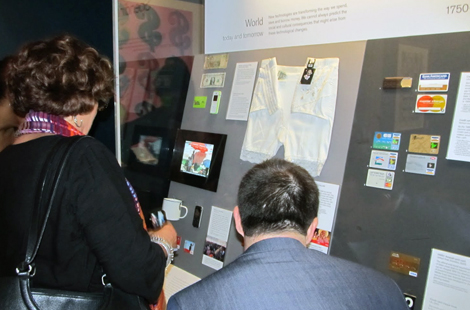Another reason to visit London this summer

Another reason to visit London this summer
- June 26, 2012
- UCI’s IMTFI helps curate mobile money exhibit at the British Museum
 Going to London anytime soon? If you’re visiting for the Olympics or just on a holiday,
your trip shouldn’t be considered complete without a visit to the British Museum.
There, you’ll see the Rosetta Stone, the famous Discobolus sculpture, and artifacts
from ancient Mesopotamia, Egypt… and UC Irvine? That’s right: if you wander into the
Citi Money Gallery, the placard on the wall recognizes the curatorial contributions from the Bank of
England Museum, the Royal Mint Museum, and UCI’s Institute for Money, Technology and Financial Inclusion (IMTFI).
Going to London anytime soon? If you’re visiting for the Olympics or just on a holiday,
your trip shouldn’t be considered complete without a visit to the British Museum.
There, you’ll see the Rosetta Stone, the famous Discobolus sculpture, and artifacts
from ancient Mesopotamia, Egypt… and UC Irvine? That’s right: if you wander into the
Citi Money Gallery, the placard on the wall recognizes the curatorial contributions from the Bank of
England Museum, the Royal Mint Museum, and UCI’s Institute for Money, Technology and Financial Inclusion (IMTFI).
The newly-reopened gallery displays objects from around the world – some more than 4000 years old – that tell the history of money. Featured items include some of the world’s first coins, early examples of paper currency, counterfeit money, and traditional jewelry made of money. The exhibit also includes two display cases containing items representing the more recent history of money, from credit cards to mobile phone payment systems, thanks to the help of IMTFI which, since 2008, has been funding research on how new technologies impact peoples’ saving and spending habits. The selection includes a wooden money box from India, donated by Mani Nandhi; a clay money box from Nigeria, donated by Isaac Oluwatayo; and a painted tin Green Bank money box from the Philippines, donated by Green Bank through Anatoly “Jing” Gusto.
“It was a natural collaboration,” says IMTFI director and anthropologist Bill Maurer, who attended the gallery opening on June 12. “The curator and I had met at a conference. She was interested in adding the next stages of the evolution of money to the gallery, and in making the exhibit more interactive.”
Maurer used his network of more than 100 researchers supported by IMTFI to bring both traditional piggy banks and mobile money related objects to the institute’s last conference, held in December 2011 at UCI. British Museum curator Catherine Eagleton also attended, with an empty suitcase. She worked closely with Erin Taylor, Espelencia Baptiste and Heather Horst, IMTFI’s Haiti research team which documented the roll-out of mobile financial services there in the wake of the country’s massive earthquake. Among the objects they helped bring to the display are a Haitian mobile phone that can send and receive money via text message, and a special pair of women’s undergarments with hidden pockets for cash.
“This display looks at money from prehistory to the present, which helps us to understand where it might be going in the future,” says Eagleton. “We hope that people will go away thinking a little differently about the cash in their pocket.”
Items in the cases will be rotated over the next five years, and Eagleton plans to continue working with IMTFI to collect and curate objects that will help explain the origins and meanings of money through time.
If you don’t have plans to visit London in the next five years, you’re still in luck. A smaller-scale exhibit, “From Gold to Gigabytes: The Past, Present and Future of Money,” will be on display in UCI’s Langson Library October 2012-April 2013. Maurer and Eagleton will open the exhibit with a public reception October 5. Stay tuned for more details.
pictured: IMTFI researchers donated to the display a Haitian mobile phone that can
send and receive money via text message, and a special pair of women’s undergarments
with hidden pockets for cash. Photo and story courtesy of IMTFI.
Share on:




connect with us